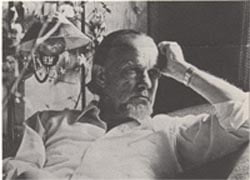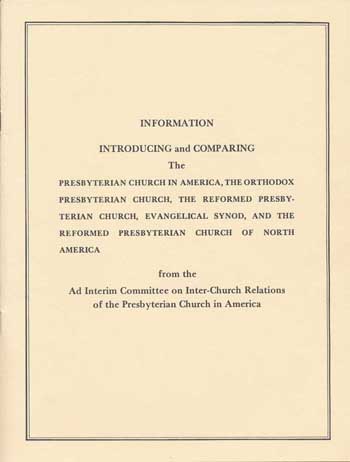The published histories of individual churches tend to be a very overlooked literary genre. Usually they are published in limited edition and purchased by church members, only to be shelved and perhaps never read. This is unfortunate, for some of these works have provided occasion for pastors and theologians to wax eloquent on various themes long pondered in their ministry.
What follows is excerpted from Historical Sketch of Rising Sun, Indiana, and the Presbyterian Church. A Fortieth Anniversary Discourse, delivered Sept. 15, 1856, by Rev. B.F. Morris, and is edited for length. In opening his discourse, Rev. Morris sets out to establish the value of historical annals. This is something of a digression from our normal fare here, I realize. Moreover, we may not agree with all of his statements. But consider this a “think piece,” designed to make us consider more fully the many aspects of the otherwise acknowledged value of historical accounts.
THE VALUE AND USE OF HISTORICAL ANNALS.
1. Historic annals are the way-marks of human progress.
The unfolding events which men and communities evolve need an imperishable record. This record is the embalming process that preserves the precious treasures of the past from oblivion, and transmits them, in their original freshness and form, to future ages.
2. They are “sunny memories” of scenes, fragrant with delightful and profitable remembrances to our personal experience.
Our elevated personal enjoyments flow, mainly, from two sources; one from the duties, activities and scenes of the present; the other from the fresh and vivid remembrance of the past. The past is a field through which all, in retrospection, love to roam, gathering in their own hearts, and reproducing in their own recollections, the scenes and stirring events in which they participated, and which, in remembrance, yield a rich harvest of personal enjoyment.
3. Past records and remembrances also have their genial and beneficent influences for the rising generation.
The solid texture in the life and character of each generation is woven mainly from the materials created and fashioned by the one preceding. The type of life, the ruling sentiments of the soul and whatever goes into the composite form of character, come mainly from influences that flow from the generations that have gone before.
4. They have a significant and important relation and use to the future.
Preparation for right action and a true course in life is one of the most commanding obligations of human existence. We must live right now, so that we may act right in the future. This consummation is greatly aided by the moral teachings of the past. The dividing line between right and wrong; the true principles and pathway of success; dangers to be avoided; wisdom and prudential sagacity, all that forewarns and forearms and qualifies for right action, may be derived from the facts and lessons of the past, communicated by oral experience, or through historic annals. “It is the capacity of looking back on past experiences, which gives us the power of foreseeing the future, and thus of looking both before and behind, for sources of enjoyment,” and for a true direction in the moral course of life. This fact, in God’s system of moral education, gives meaning and authority to the Divine injunction, “Remember the days of old; consider the years of many generations; ask thy father and he will shew thee; the elders and they shall tell thee.”—Deut. 32:7. “Tell ye your children of it, and let your children tell their children, and their children another generation.”—Joel 1:3. In this light historic annals assume an importance equal to the value of the moral interests of men and society, as effected by the moral education of the rising generation.
5. They embalm the acts and memories of the dead.
The great forest of humanity, like a forest of oaks, falling before the march of civilization, is, one by one, leveled by the axe of time. The oak of human life, stately and strong though it be, has no perpetual charter. A century, at most, it must fall, and pass away. Shall it have no record in human remembrance, or on the historic page?
6. Historic annals are the means to measure social progress, as contrasted with after eras in the history of social civilization.
Society, as it circles outward from a common center, has a tendency to degenerate from its original and higher type, into one of a lower standard and tone.
7. Another special and important use of historic annals and personal remembrances is the exhibition of the nature, progress, and triumphs of Christian truth.
The structure of all human society must, if its foundation be solid and its superstructure symmetrical and safe, rest on Christian truth.
8. This suggests another great and valuable use of historic annals and personal remembrances, which is to demonstrate the active presence of God in human history and society.
“Historic truth,” says Bancroft, “may be established as a science; and the principles that govern human affairs, extending like a path of light from century to century, become the highest demonstration of the superintending providence of God. Universal history does but seek to restate “the sum of all God’s works of Providence.”
A devout and thoughtful mind will recognize and adore God, as He gives revelations of Himself in human history, and in every onward movement of the race.
Words to Live By:
Have you noticed, as you read through the Bible, how often God commands us to remember His works? To be actively engaged in that work of remembrance is key to keeping our hearts fresh before the Lord. Consider the words of John Flavel :
“Search backward into all the performances of Providence throughout your lives. So did Asaph: ‘I will remember the works of the LORD: surely I will remember thy wonders of old. I will meditate also of all thy work, and talk of thy doings’ (Psalm 77:11, 12). He laboured to recover and revive the ancient providences of God’s mercies many years past, and suck a fresh sweetness out of them by new reviews of them. Ah, sirs, let me tell you, there is not such a pleasant history for you to read in all the world as the history of your own lives, if you would but sit down and record from the beginning hitherto what God has been to you, and done for you; what signal manifestations and outbreakings of His mercy, faithfulness and love there have been in all the conditions you have passed through. If your hearts do not melt before you have gone half through that history, they are hard hearts indeed. ‘My Father, thou art the guide of my youth’ (Jeremiah 3:4)”.—From The Mystery of Providence, chapter nine.


